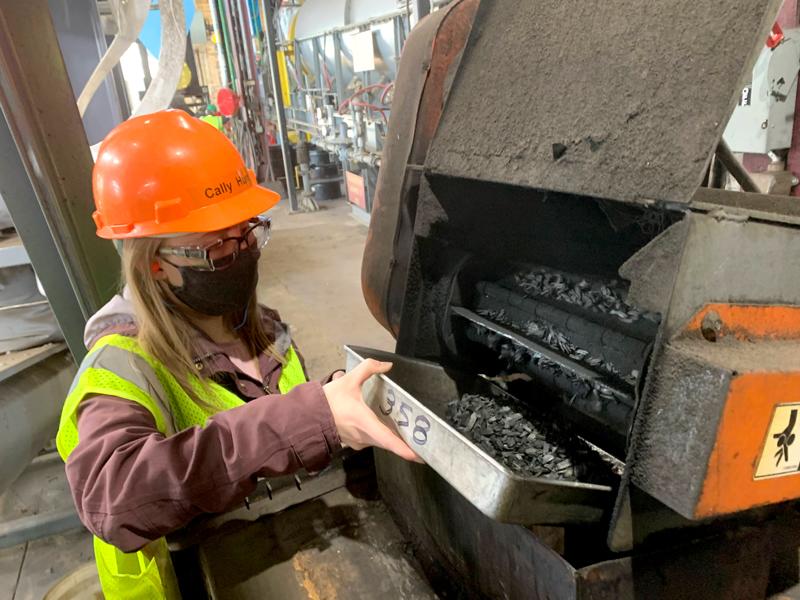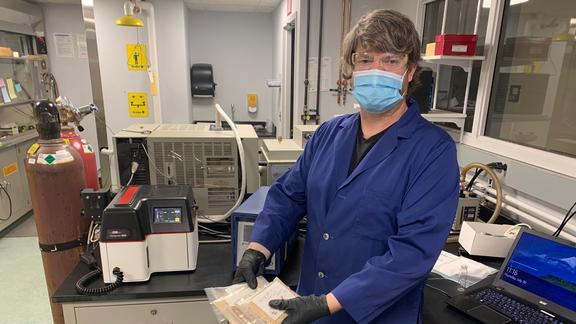
Program Overview
Carbon is an essential element in nature. Functional biocarbon materials are developed to utilize waste biomass resources as high value carbon-based product for a variety of applications. For example, biochar is a stable, carbon-dense material that can sequester atmospheric carbon dioxide for millenia while providing benefits to soil, water, and plants. Other materials can also be developed, such as sorbents for water and air purification, composite fillers, and battery components.
NRRI leads an interdisciplinary program in pyrolytic technologies to produce functional biochar materials through substantial investments in biomass thermal processing equipment at the bench and pilot scales. This is supported by unique capabilities in materials characterization and chemical modifications.
Collaborations with external partners include:
- Urban, agriculture and forest soil enhancement
- Water treatment
- Landfill remediation
NRRI is also pursuing new opportunities in metallurgy, energy, and infrastructure.
NRRI R&D programs have produced these materials from wood and agricultural residuals over the past ten years with pilot facilities designed to treat biomass for energy applications. Further strategic investments in equipment and facilities allow us to produce more technically challenging materials that require stringent processing conditions, and focus on the stepwise scale-up from the laboratory to the pilot scale.
Program Goals
- To establish a diverse and sustainable biochar industry for Minnesota.
- To develop co-production of bioenergy with biochar.
- To assist partners with biochar demonstrations aimed at encouraging carbon sequestration, soil improvement, water treatment, and sustainable management of forest and urban trees.
- To work with external partners to establish biochar specifications for biochar used in different applications.
Unique Strengths, Expertise and Capabilities
- Biochar properties analysis
- Process development and scale-up
Projects, Funding
- Biochar for Forest Health (LCCMR Forest & Bioeconomy)
- USFS Wood Innovations Grant
Partnerships
NRRI statewide partnerships include
- City of Minneapolis
- Cloquet Forestry Center
- MN Forest Resources Council
- University of MN/Extension
- MN Forestry Industry
- MN Mining Industry
- MN Power
Resources
Biochar Information
NRRI Biochar research solutions include:
- Resource procurement to material properties
- Custom biochar product development
- Applications in soil health, water remediation, materials development & energy
Biochar Impacts for Minnesota - a component of high-value products
- Carbon sequestration
- Agricultural and forest soil health
- Water treatment: excessive nutrients and other pollutants
- Forest fire fuel reduction
- New markets for residual forest biomass (materials, energy)
- New jobs for the Minnesota forest industry and beyond
Biochar Primary Sources
- Forest/Mill Residuals
- Low value species
- White-wood pellets
- Pest-killed Trees
Biochar Secondary Sources
- Agricultural residues
- Water treatment biosolids
- Manure management
Beneficial Attributes
- Stable carbon
- Absorption
- Water retention
- Microbial habitat
- Soil structure
Staff
Related News

Eighteen months ago, Jeff Kinkel took on a challenging role at NRRI that makes him grateful for the team approach.

Biochar is gaining interest around the globe. NRRI is working to understand its potential for environmental remediation and as a new market for forest resources.

Meet the Researcher: Brian Barry enjoys transforming biomass into high value products.

You know charcoal. (Summer picnic, anyone?) But do you know about the economic and environmental benefits of its close cousin, biochar?
Media Coverage
- – Minneapolis is on the leading edge of biochar, a carbon sequestering material full of promise and still under research – Star Tribune
- – NRRI Works To Develop “Green Steel” Making Process – KDAL
- – NRRI receives grant to replace fossil fuel in some steelmaking – Business North
- – Northland researchers look to biochar as possible climate solution – Duluth News Tribune
- – Study looks into biochar for battery recycling – Waste & Recycling Magazine
- – Multi-Year Initiative Funded by the U.S. Department of Defense (DOD) Aims to Support a More Resilient and Sustainable Domestic Supply Chain by Investing in Next Generation Metal Recycling Technologies – Waste Advantage Magazine
- – Earth Month: NRRI’s Biochar research – WDIO
- – Biochar forestry could reduce wildfire risk and capture carbon – Quetico Superior Wilderness News
- – Forest Service partners with researchers to transform wildfire fuel into biochar in Superior National Forest – WTIP






